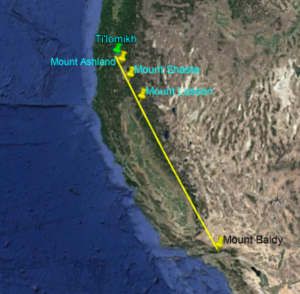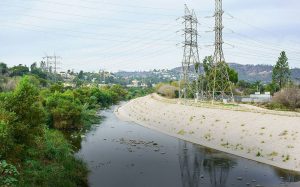
I live just west of Maaw’nga, a village of the Tongva Chumash tribe. This community extends north from Puvungna — Long Beach — to the largest Tongva village, Yaanga, in what is now downtown Los Angeles. The Los Angeles River runs through Yaanga. To the north and west lies the protective arm of Cahuenga Mountain, northernmost peak of the San Bernardino mountains. In the crook of Cahuenga’s arm sits my village, Maaw’nga and the HOLLYWOOD sign.
The neighborhoods are beginning to welcome Paayme Paxaayt back into their lives.
A one-hour drive eastward on a concrete freeway from my village, Mount Baldy rises out of Tongva territory in the San Gabriel mountains. The top of Mount Baldy has been considered the focal point for cosmic energy by the Tongva people for a thousand years.
 Last year, a Shasta region habitue and steward named Robert Bobcat Brothers watched the high-altitude flight of an Osprey and sensed that the high flying bird was following a powerful trajectory. It was heading in a straight line southward from Ashland Mountain toward Mount Baldy.
Last year, a Shasta region habitue and steward named Robert Bobcat Brothers watched the high-altitude flight of an Osprey and sensed that the high flying bird was following a powerful trajectory. It was heading in a straight line southward from Ashland Mountain toward Mount Baldy.
Bobcat surmised that The Osprey’s Path may reveal a power band that begins with Ti’lomikh Falls on Oregon’s Rogue River, home to a sacred salmon ritual and the origin story of the Takelma people. The band of power then continues in a straight line through the granite masses of Mount Ashland, Mount Lassen, and Mount Shasta and hundreds of miles southward to Mount Baldy in Tongva land. “We had no idea there was a straight-line connection between all these special places,” Bobcat wrote, “but the ceremonies felt powerful. Discovering this deep Earthly connection between sacred sites reaching over 600 miles, we are inspired to learn more about how we can honor and use this gift in the best way for all beings.”
In addition to the power band revealed by the Osprey’s path, the heart line of my regional Tongva land extends westward from the watershed of the San Gabriels, across the Los Angeles basin, and out to sea. The heart line includes the four Channel Islands. Paayme Paxaayt, the river artery feeds the Tongva heart line; we call it the Los Angeles River.
Like the freeways that divide the land with concrete, the main artery of the Tongva world, Paayme Paxaayt, has been filled with concrete. As with cholesterol in animals, cement is impossible to remove from the heartland’s arteries. The river has been clogged has been with a 51-mile scar,” Marissa Christenson, chairperson of Friends of the Los Angeles River has said. When it was encased in concrete, the river’s place in the ecosystem was incarcerated. It could no longer flow freely, to oxygenate and nourish animals and people. The heart line became barren and needy and, in turn, its villages became barren and needy. “So,” Marissa Christenson continued, “we have all sorts of different wounds to heal in Los Angeles.”
 Healing is a good way to think about recycling. Healing Paayme Paxaayt, the Los Angeles River, begins with cleanup of the detritus of a century. The river has been imprisoned in concrete from one side; its concrete serves as a wall from the other side. Slowly, people and animals are regaining access. With them, they have brought indigenous vegetation and the universal signature of human presence, pathways. Now boots, boats, and bicycles move along the river, moving around rather than breaking down the concrete. The neighborhoods are beginning to welcome Paayme Paxaayt back into their lives. I’d call that recycling, wouldn’t you?
Healing is a good way to think about recycling. Healing Paayme Paxaayt, the Los Angeles River, begins with cleanup of the detritus of a century. The river has been imprisoned in concrete from one side; its concrete serves as a wall from the other side. Slowly, people and animals are regaining access. With them, they have brought indigenous vegetation and the universal signature of human presence, pathways. Now boots, boats, and bicycles move along the river, moving around rather than breaking down the concrete. The neighborhoods are beginning to welcome Paayme Paxaayt back into their lives. I’d call that recycling, wouldn’t you?
# # #
Writer, editor, and educator based in Los Angeles. He's also played a lot of music. Degelman teaches writing at California State University, Los Angeles.
Degelman lives in the hills of Hollywood with his companion on the road of life, four cats, assorted dogs, and a coterie of communard brothers and sisters.



Charles, Fascinating tale but how did the government defend cementing up that stretch of river – obviously with no thought for the ecology or the tribespeople. Awful!
The L.A river flows to the sea across the alluvial plain of the San Fernando Valley and downtown. It is susceptible to dry desert conditions that turn to flash flood conditions. Encasing the river came in the 1920s and ‘30s as the city rapidly grew and the Depression-Era WPA made civic ‘improvement’ possible.
The indigenous people like the Tongva had been liquidated or rendered irrelevant and enviro consideration lay 50 years in the future. Flood control was the order of the day.
If you can separate the artist from his work, Roman Polanski’s “Chinatown,“ brilliantly researched and written by Robert Towne, in addition to being a beautiful period piece and a powerfully dark drama, tells volumes about the history and exploitation of LA’s most valuable commodity-—water.
Thanx for explaining Charles, just read Louise Erdrich’s semi-autobiographical novel Night Watchman about the government’s attempts in the 1950s to pass “termination” bills that would have negated long-standing treaties and deprived North Dakota tribes of their land and livelihood – unbounded cruelty.
Yeah, Erdrich has an authentic voice and purpose in her work. Amazing that she can be so lyrical about such outrages. It speaks to a balance she must carry inside her >>> that keeps her from flipping out. And she’s just one voice in that cloud of ghosts and survivors.
You certainly do find unusual ways to respond to our prompts these days. Very interesting take on recycling. Thanks for adding to the conversation.
Thanks, Suzy —- plenty of folks were talking about collecting cans and bottles, so I thought I’d discuss reinhabitory practices, a fundamental recycling process that many respected friends have dedicated their lives to and that address root causes of pollution and Earth deterioration with profound remedies. I’m glad you found it ‘interesting.’
By putting quotation marks around “interesting,” you show your disapproval of my word choice. Perhaps you would have liked it better if I had said “fascinating” — which it was.
Thanks, Suzy. I’m preparing another piece on reinhabitory practices which I feel are accessible and uplifting versions of recycling.
It’s inspiring, Charles, that reinhabitory practices are taking place. I had no knowledge of the spiritual significance and the geography of this area, no doubt because the history of the first people there was erased from the mainstream. It’s good to know about this. Also, I couldn’t help thinking, while looking at your map of the osprey’s flight, that the straight line looked somewhat like the San Andreas fault, even though it’s too far east. It wouldn’t surprise me that the native Americans could have had some intuitive feeling about the earth that lies beneath us.
I find it helps me identify with my surroundings to know the placement and significance of the cultures and artifacts that preceded our giant footprint[s]. And the more I know about indigenous precedents, the less I see the distinction between their spiritual/intuitive perceptions and actions and our empirical POVs. You’ve aroused my curiosity about how indigenous people experienced and described earthquakes. I bet they had a ton to say about them.
Charles, this was so interesting (no quotes). I learned a lot, and really liked your mention of “Chinatown” too (yes, a great movie, despite the Polanski connection). The indigenous people we pushed off the land so many years ago, knew how to preserve, maintain, recycle and protect their domain and we have a lot to learn from their natural ways. Thank you for giving us this point of view.
Thanks, Betsy. I learned a great deal about the privatization of LA’s water from “Chinatown.” I think Robert Towne’s script had a great deal to do with the depth of knowledge in the film. And your description of the indigenous ‘stewardship’ of the land was great, although I think they would not claim they were stewards. They just coexisted with the territory and all its beings, including its spirits!
I love the concept of healing the earth’s wounds, sadly inflicted by us. Thanks for a unique take on recycling.
Thanks, Laurie.
What a great take on “recycling”, Charles. Thanks.
Thanks, Tom.
Brilliant story, Charles, and wonderfully told. And, as an Easterner, I knew nothing about. Although, as you note in one of your comments above, I did think of “Chinatown,” and how it is all about water in LA, while reading it.
And your observation that recycling is a form of healing — again, something I hadn’t really thought about before — is spot on.
Thanks, John. I find it comforting, especially in LA, which suffers from concrete suffocation, to understand what went on beyond the oft-recorded landscapes of LA under development, from the horror of the missions to our current state. Recycling the former realities brings them out of the uselessness of nostalgic history to the possibility of healing.
As we try to understand how to successfully live on the planet without destroying it, many people are coming to appreciate indigenous knowledge and understanding of the connection of the earth and all beings. It is highly visible in British Columbia and other parts of the Americas where the erasure of indigenous history is not quite as complete as in LA, though everywhere it is fraught. Your story resonates widely. So much to learn and so far to go.
I’ve been lucky enough to gain at least a superficial entrance to that knowledge via the writing of Gary Snyder, during my many years in SF and even before, in high school, with all that romantic beat writing — also Wendell Berry in Kentucky. There has been real forward movement toward indigenous restoration of languages and ‘the old ways’ including tattooing! Here’s one of Wendell Berry’s poems that I’m pretty wild about, written in the ’70s: https://bookpeopleblog.com/2011/04/05/poem-of-the-day-manifesto-the-mad-farmer-liberation-front/
Thank you for that beautiful and timeless poem. It resonates today as much as when it was written—maybe more so.